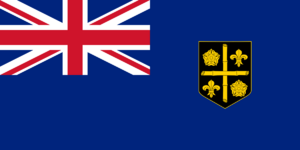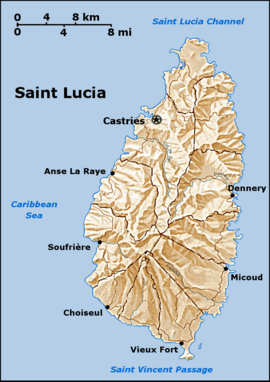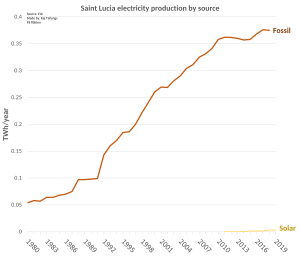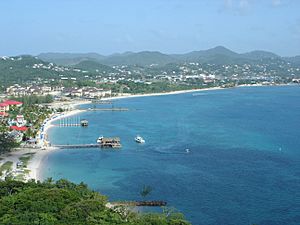Saint Lucia facts for kids
Quick facts for kids
Saint Lucia
Sent Lisi (Saint Lucian Creole French)
|
|
|---|---|
|
|
|
|
Motto: "The Land, The People, The Light"
|
|
|
Anthem: "Sons and Daughters of Saint Lucia"
|
|

Location of Saint Lucia (circled in red)
in the Caribbean |
|
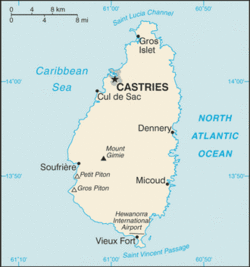 |
|
| Capital and largest city
|
Castries 13°53′00″N 60°58′00″W / 13.88333°N 60.96667°W |
| Official languages | English |
| Vernacular languages |
Saint Lucian Creole French |
| Ethnic groups
(2020)
|
|
| Religion
(2020)
|
|
| Demonym(s) | Saint Lucian |
| Government | Unitary parliamentary constitutional monarchy |
|
• Monarch
|
Charles III |
| Errol Charles (acting) | |
| Philip J. Pierre | |
| Legislature | Parliament |
| Senate | |
| House of Assembly | |
| Independence | |
|
• Associated State
|
1 March 1967 |
|
• Independence from the United Kingdom
|
22 February 1979 |
| Area | |
|
• Total
|
617 km2 (238 sq mi) (178th) |
|
• Water (%)
|
1.6 |
| Population | |
|
• 2018 estimate
|
|
|
• 2010 census
|
165,595 |
|
• Density
|
299.4/km2 (775.4/sq mi) (29th) |
| GDP (PPP) | 2023 estimate |
|
• Total
|
|
|
• Per capita
|
|
| GDP (nominal) | 2023 estimate |
|
• Total
|
|
|
• Per capita
|
|
| Gini (2016) | 51.2 high |
| HDI (2022) | high · 108th |
| Currency | East Caribbean dollar (XCD) |
| Time zone | UTC−4 (AST) |
| Driving side | left |
| Calling code | +1 758 |
| ISO 3166 code | LC |
| Internet TLD | .lc |
Saint Lucia is an island country located in the eastern Caribbean Sea. It is part of the Windward Islands in the Lesser Antilles. The island is north of Saint Vincent and south of Martinique. It covers about 617 square kilometers (238 sq mi). In 2018, its population was over 180,000 people. The capital and largest city is Castries.
The first people to live on the island were the Arawaks, arriving around 200–400 AD. Later, around 800 AD, the Kalinago took control. The French were the first Europeans to settle there. They signed a treaty with the native Caribs in 1660. The English took control in 1663. Over many years, England and France fought 14 times for the island. Because of this, Saint Lucia was often called the "Helen of the West." This name comes from Helen of Troy in Greek myths. The British finally gained full control in 1814.
Saint Lucia began to have its own government in 1924. Everyone could vote by 1951. From 1958 to 1962, the island was part of the West Indies Federation. On February 22, 1979, Saint Lucia became an independent country. It remains a Commonwealth realm, which means the British monarch is its head of state.
Saint Lucia is a member of many international groups. These include the United Nations, the Organization of American States, and CARICOM.
Contents
What's in a Name? The Story of Saint Lucia's Name
Saint Lucia is named after Saint Lucy of Syracuse, a Christian saint who lived from 283 to 304 AD. It is one of only two countries in the world named after a female person. The other is Ireland, named after a goddess.
One story says that French sailors were shipwrecked on the island on December 13. This day is Saint Lucy's feast day. So, they named the island in her honor. Another idea comes from a globe made in 1520. This globe, found in the Vatican, shows the island as Sancta Lucia. This suggests early Spanish explorers might have named it.
The Arawak people first called the island Louanalao around 200 AD. This means "Island of the Iguanas." When the Carib people arrived around 800 AD, they called it Hewanorra. This means "there where iguanas are found."
Saint Lucia's Past: A Brief History
Early Inhabitants: Who Lived Here First?
The first known people to live in Saint Lucia were the Arawaks. They came from northern South America around 200–400 AD. We know this because archaeologists have found their pottery on the island.
Around 800 AD, the Kalinago (also called Island Caribs) arrived. They took control from the Arawaks.
European Arrivals: Who Came Next?
It's possible that Christopher Columbus saw the island in 1502. However, he didn't write about it. A map from 1500 by Juan de la Cosa shows an island called El Falcon. This might have been Saint Lucia.
In the late 1550s, a French pirate named François le Clerc used Pigeon Island as a base. He attacked Spanish ships from there. In 1605, an English ship landed on Saint Lucia by accident. The 67 colonists tried to settle, but the Caribs attacked them. Only 19 survived, and they left the island. The English tried again in 1638 but faced more hostility.
The French successfully claimed the island in 1650. They signed a treaty with the Caribs in 1660. In 1664, the English tried to take Saint Lucia again. But they left in 1666. The French then took full control. Saint Lucia became an official French colony in 1674. It was managed by Martinique.
Changing Hands: The 18th and 19th Centuries
Saint Lucia became very important because of the sugar industry, which used enslaved people. Both the British and the French wanted control. During the 1700s, the island changed hands many times. It was even declared neutral territory. But French settlements remained.
In 1722, George I of Great Britain gave Saint Lucia to the Duke of Montagu. The Duke sent Nathaniel Uring to set up a settlement. But the French quickly drove them away.
During the Seven Years' War, Britain held Saint Lucia for a year. They gave it back to the French in 1763. In 1765, the French started growing sugar cane on large plantations. The British took the island again in 1778.
From 1782 to 1803, control of the island kept switching. During the French Revolution, France sent people to Saint Lucia to spread new ideas. Enslaved people began to leave their plantations. In 1794, France officially ended enslavement. But then, British forces captured Saint Lucia. Soon, French soldiers and escaped enslaved people, called L'Armee Française dans les Bois, fought back. This started the First Brigand War.
In 1796, Castries was burned during the fighting. General John Moore recaptured a fort called Morne Fortune for the British.
In 1803, the British took control again. Many of the L'Armee Française dans les Bois escaped into the rainforest. They formed communities of maroons.
Slavery continued for a short time. But Britain was moving to end the slave trade. In 1807, Britain abolished the slave trade. This meant no more enslaved people could be brought to the island.
France and Great Britain kept fighting over Saint Lucia. Finally, Britain secured it in 1814. This was part of the Treaty of Paris, which ended the Napoleonic Wars. After this, Saint Lucia became a British colony.
Slavery was completely abolished on the island in 1834. This happened across the British Empire. After this, former enslaved people had to work for their old masters for four years. This was to help them get used to freedom. Full freedom was given in 1838. By then, most people on the island were of African descent.
Modern Times: The 20th Century and Beyond
Saint Lucia got its first representative government in 1924. The first election was held in 1925. Many Saint Lucians fought in the Second World War. The war even reached the island. A German U-boat sank two British ships in Castries harbor in 1942. The United States used the island as a military base during the war.
Everyone could vote by 1951. In 1958, Saint Lucia joined the West Indies Federation. But this group broke up in 1962. In 1967, Saint Lucia became a self-governing state. It gained full independence peacefully in 1979. Sir John Compton led the country to independence. Saint Lucia remained part of the British Commonwealth. Elizabeth II was still its Queen, represented by a Governor-General.
In 1980, Hurricane Allen hit the island. It damaged much of Saint Lucia's buildings and slowed its economy. In the 1990s and 2000s, the country's economy changed. It moved from farming to tourism. This happened under the leadership of Kenny Anthony.
Geography: Exploring Saint Lucia's Landscape
Saint Lucia is a volcanic island. This means it has many mountains. Its highest point is Mount Gimie, which is 950 meters (3,117 feet) above sea level. The Pitons are two famous volcanic peaks. They are a well-known landmark. Saint Lucia also has the world's only drive-in volcano, the Sulphur Springs.
There are small islands off the coast. The largest are the Maria Islands in the southeast. Saint Lucia is located at 14° N latitude and 61° W longitude. Most people live near the coast. The island's interior has dense forests and fewer people.
Saint Lucia is home to unique animals. These include the Anolis luciae, a type of lizard, and the Boa orophias, a type of snake. The island has different types of forests and plant life.
Climate: What's the Weather Like?
Saint Lucia has a tropical climate. This means it's warm all year round. Northeast trade winds help keep the weather pleasant. There is a dry season from December to May. The wet or rainy season is from June to November.
Average daytime temperatures are around 30°C (86°F). Nighttime temperatures are about 24°C (75°F). Because it's close to the equator, the temperature doesn't change much between winter and summer.
| Climate data for St Lucia | |||||||||||||
|---|---|---|---|---|---|---|---|---|---|---|---|---|---|
| Month | Jan | Feb | Mar | Apr | May | Jun | Jul | Aug | Sep | Oct | Nov | Dec | Year |
| Mean daily maximum °C (°F) | 29 (84) |
29 (84) |
29 (84) |
30 (86) |
31 (88) |
31 (88) |
31 (88) |
31 (88) |
31 (88) |
31 (88) |
30 (86) |
29 (84) |
30 (86) |
| Daily mean °C (°F) | 26 (79) |
26 (79) |
26 (79) |
27 (81) |
28 (82) |
28 (82) |
28 (82) |
28 (82) |
28 (82) |
28 (82) |
27 (81) |
26 (79) |
27 (81) |
| Mean daily minimum °C (°F) | 23 (73) |
23 (73) |
24 (75) |
24 (75) |
25 (77) |
25 (77) |
25 (77) |
25 (77) |
25 (77) |
25 (77) |
24 (75) |
24 (75) |
24 (76) |
| Average precipitation mm (inches) | 125 (4.9) |
95 (3.7) |
75 (3.0) |
90 (3.5) |
125 (4.9) |
200 (7.9) |
245 (9.6) |
205 (8.1) |
225 (8.9) |
260 (10.2) |
215 (8.5) |
160 (6.3) |
2,020 (79.5) |
| Average precipitation days | 14 | 9 | 10 | 10 | 11 | 15 | 18 | 16 | 17 | 20 | 18 | 16 | 174 |
| Mean monthly sunshine hours | 248 | 226 | 248 | 240 | 248 | 240 | 248 | 248 | 240 | 217 | 240 | 248 | 2,891 |
| Source: climatestotravel | |||||||||||||
Geology: How Was Saint Lucia Formed?
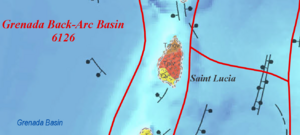
Saint Lucia was formed by volcanoes. The oldest rocks are in the north, from 16 to 18 million years ago. The central part of the island has rocks from 10.4 to 1 million years ago. The southwest has newer volcanic activity.
This newer area is called the Soufriere Volcanic Centre (SVC). It includes the Qualibou depression. This depression is about 10 km (6.2 mi) wide. It formed about 100,000 years ago. The SVC is known for its hot springs and steam vents, especially at Sulphur Springs.
The famous Petit Piton and Gros Piton are also volcanic domes. They formed within this depression.
Government: How Saint Lucia is Run
Saint Lucia is a unitary state with a parliamentary system. This means the central government holds most power. It is also a Commonwealth realm and a constitutional monarchy. This means Charles III is the King, but his power is limited by a constitution. He is represented on the island by a Governor-General.
The prime minister is the head of the government. They lead the cabinet. The prime minister is usually the leader of the largest party in the House of Assembly. The House of Assembly has 17 members. Each member is elected by voters in their local area. The Senate is the upper part of Parliament. It has 11 appointed members. Most are chosen by the prime minister.
Administrative Divisions: Saint Lucia's Districts
Saint Lucia is divided into 10 districts. The French colonists created these districts and gave them names. The British kept these names, but changed them slightly to sound more English. The largest district in both size and population is Castries. This is where the capital city, also called Castries, is located.
Here are the 10 districts in alphabetical order:
Foreign Relations: Saint Lucia's Friends Around the World
Saint Lucia is part of many international groups. These include the Caribbean Community, the OECS, and La Francophonie. As a Commonwealth Realm, Saint Lucia has good relationships with the United Kingdom and Canada. France is also an important friend. This is partly because Saint Lucia shares a border with Martinique, which is French.
The United States is Saint Lucia's biggest trading partner. Saint Lucia does not have its own military. However, the Royal Saint Lucia Police Force has a Special Service Unit (SSU) and a Coast Guard.
Economy: How Saint Lucia Makes Money
Saint Lucia is a Small Island Developing State. This means it's a developing country with special challenges because it's an island. The service sector is the biggest part of its economy. This includes things like tourism. In 2020, services made up 86.9% of the country's economy. Industry was 10.9%, and farming was 2.2%.
Saint Lucia has attracted foreign businesses and investments. This is because it has a skilled workforce and good roads, communication, and ports. Like many small islands, tourism and banking are the main ways Saint Lucia earns money. Farming, especially bananas, used to be the biggest part of the economy. But its importance has gone down.
Saint Lucia's currency is the Eastern Caribbean Dollar (EC$). This currency is used by several countries in the region. The country's main trade partners are the US, UK, EU, and other CARICOM countries.
Tourism: Visiting Saint Lucia
Tourism is the biggest part of Saint Lucia's economy. More tourists visit during the dry season, from January to April. Saint Lucia is a popular place to visit. People love its tropical weather, beautiful scenery, beaches, and resorts. In 2019, 1.29 million visitors came to the island.
Some popular tourist spots include the Sulphur Springs, the Botanical Gardens, Pigeon Island, and The Pitons.
Agriculture: Farming on the Island
Farming used to be the main way Saint Lucia made money. This was mostly from exporting bananas. However, farming is now less important. This is partly because of more competition from South American countries in the banana market. Still, farming is important. It provides 7.9% of jobs and contributes 2.2% to the economy.
About 18% of the land is used for farming. Bananas are still the main crop. Other important crops include coconuts, cocoa beans, mangoes, and vegetables. Saint Lucia also has a small livestock sector, mainly poultry. The island produces enough eggs for itself. Fishing is also important to the economy.
Infrastructure: Getting Around Saint Lucia
Saint Lucia has a good public bus system. It covers most of the island. Private individuals own the buses. The government sets the routes and bus stops. Roads cover most of the island. However, some rural areas still need better roads.
The island has two airports. One of them is an international airport. Cruising and yachting are also very important to the economy. The main seaport is in Castries. The main marina is in Rodney Bay. The island's main oil refinery is in Bexon.
Saint Lucia gets most of its electricity from oil. This comes from the Cul De Sac Power Station. Solar energy is also a big source of power. There have been efforts to use geothermal and wind power too.
Demographics: Who Lives in Saint Lucia?
Saint Lucia usually counts its population every 10 years. In 2010, the population was 165,595 people. This was a 5.1% increase from 2001. Children aged 0–14 made up 24.1% of the population. People aged 65 and over made up 8.6%. Almost 40% of the island's people lived in the District of Castries.
In 2021, Saint Lucia had a low birth rate, with 1.4 children per woman. This is much lower than in 1990 (3.4 children) and 1959 (6.98 children). Many Saint Lucians move to other English-speaking countries. The United Kingdom has almost 10,000 Saint Lucian-born citizens. The United States and Canada are also home to many Saint Lucians. The average age of Saint Lucians was 33.1 years in 2021.
Ethnic Groups: The People of Saint Lucia
Saint Lucia was first home to Amerindian people. But European colonization caused their numbers to drop. Most early European settlers were white planters. However, enslaved Africans and indentured servants brought by Europeans eventually became the majority. Because of this, most of Saint Lucia's population is of African and mixed descent.
In 2010, 85.3% of the people were black. 10.9% were of mixed race. Other groups include Indo-Caribbean people (2.2%), whites (0.6%), and Indigenous people (0.6%). A small number of Kalinago people live in the Choiseul region. There are also small groups of Lebanese and Syrians.
Languages: What Languages Are Spoken?
The official language of Saint Lucia is English. However, Saint Lucian French Creole (Kwéyòl) is widely spoken. People often call it Patois ("Patwa"). Most of the population speaks it. It is a dialect of Antillean Creole. It is also related to Haitian Creole, but it has its own unique features. The Creole language developed during French colonization. It comes mostly from French and West African languages. There have been efforts to make Creole an official language, but this has not happened yet.
Religion: Beliefs in Saint Lucia
Religion in Saint Lucia (2010 census) Christianity (90.3%) Irreligion (5.9%) Rastafari (1.9%) Hinduism (1.4%) Not Stated (1.4%)
In the 2010 census, most Saint Lucians were Christians. This is because of the French and British settlers. Due to strong French influence, most Christians are Catholics. 62.5% of the island's people identify as Catholic. 24.5% are Protestants. Also, 1.9% of the population are part of the Rastafari movement. 1.4% practice Hinduism. In 2010, 5.9% of people said they had no religion.
Saint Lucia does not have a state religion. The country's constitution protects freedom of religion. It also allows religious groups to set up schools.
Education: Learning in Saint Lucia
Most primary and secondary schools in Saint Lucia are run by the government. Education is free and required for children aged five to fifteen. This includes seven years of primary school and three to five years of secondary school. In the last two years of secondary school, students choose their subjects. This prepares them for regional CSEC exams. In 2020, the government spent 3.6% of its budget on education.
Higher education institutions are usually private. These include Monroe College and International American University. However, there are some public colleges. These include the Sir Arthur Lewis Community College and the University of the West Indies.
Healthcare: Staying Healthy in Saint Lucia
Healthcare services in Saint Lucia are provided by both the government and private groups. The island has two public hospitals and many health centers. Most dental and eye care services are private. In 2019, public spending on healthcare was 2.1%.
In 2021, the average life expectancy was 71.1 years. This was 67.8 years for men and 74.7 years for women. Life expectancy dropped compared to 2019. This was mainly due to the COVID-19 pandemic.
Culture: The Heart of Saint Lucia
Saint Lucia's culture is a mix of African, East Indian, French, and English influences. The main secondary language is Saint Lucian Creole (Kwéyòl). Most people speak it.
Saint Lucia has produced two Nobel winners. This is a very high number for a country its size. Sir Arthur Lewis won the Nobel Prize in Economics in 1979. The poet Derek Walcott received the Nobel Prize in Literature in 1992.
Saint Lucia celebrates two flower festivals. The La Rose festival is on August 30. The La Marguerite festival is on October 17. Every summer, the island hosts a carnival. This event showcases the country's culture and music. Many other music festivals also happen throughout the year.
Music: The Sounds of Saint Lucia
Saint Lucian music has strong African music influences, especially in its rhythms. Popular music styles include calypso, soca, dancehall, reggae, zouk, and folk music. Dennery Segment is a music style that started on the island. It is influenced by Angolan Kuduro, Saint Lucian Solo music, and Dancehall. The famous Saint Lucia Jazz Festival happens every year. It brings a lot of money to the country.
Food: What to Eat in Saint Lucia
Saint Lucian food is a mix of African, European, Indian, and Caribbean dishes. Some common foods include macaroni pie, stewed chicken, rice and peas, and roti (Indian flatbreads). Soups filled with fresh local vegetables are also popular. Meat and seafood are often stewed and browned. This creates a rich gravy. It is sometimes served over "ground provisions" (vegetables) or rice. Johnny Cakes, also called bakes, are common. They are served with different sides, like saltfish. The national dish of Saint Lucia is green figs and saltfish.
Sports: Playing in Saint Lucia
Like most Caribbean islands, cricket is the most popular sport in Saint Lucia. Players from Saint Lucia are part of the Windward Islands cricket team. This team plays in the West Indies regional tournament. Daren Sammy was the first Saint Lucian to play for the West Indies. He became captain in 2010. The Saint Lucia Kings is a T20 cricket team that plays in the Caribbean Premier League.
Sailing is also a major sport. The Atlantic Rally for Cruisers (ARC) race starts in the Canary Islands and finishes on the island. Other popular sports include football, basketball, tennis, golf, and volleyball. Karate and boxing have also become more popular recently.
Julien Alfred won Saint Lucia's first-ever Olympic medal. She won the women's 100 meters event at the 2024 Summer Olympics in Paris, France.
|
See also
 In Spanish: Santa Lucía para niños
In Spanish: Santa Lucía para niños
- British African-Caribbean people
- Chief Justice of the Leeward Islands
- Index of Saint Lucia-related articles
- List of Caribbean islands
- List of colonial governors and administrators of Saint Lucia
- List of Saint Lucians
- Outline of Saint Lucia
- West Indies Federation




